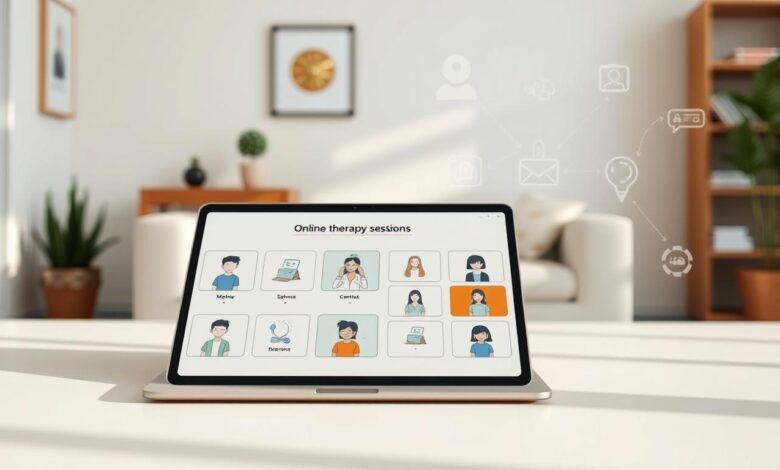Your Guide to Effective Online Therapy

Struggling to find the right support for your mental health? You’re not alone. In today’s busy world, finding time for therapy can feel impossible. But what if help could come to you—anytime, anywhere? That’s the promise of online therapy options, a growing solution in telehealth mental health that’s making care accessible like never before.
This guide is here to answer your questions. We’ll explore how to choose the right online therapy options, understand costs, and ensure your sessions are both safe and effective. Whether you’re new to therapy or looking to try virtual support, this is your roadmap.
Key Takeaways
- Online therapy offers flexible ways to access mental health care from home.
- Telehealth mental health platforms provide professional support without geographic limits.
- Costs vary, but many options fit different budgets and insurance plans.
- Selecting the right therapist and platform improves therapy outcomes.
- This guide helps you navigate every step of starting and succeeding in online therapy.
Understanding Online Therapy Options
Online therapy offers mental health support through technology. It’s great if you live far from clinics or can’t visit offices easily.
What is Online Therapy?
Online therapy uses video calls, messaging apps, or phone calls for care. It’s as good as in-person sessions but is more flexible. You can talk to licensed professionals anytime, anywhere.
These virtual counseling services include platforms for chatting with therapists or joining group sessions. Experts use the same techniques as traditional therapy. This ensures quality care without needing to be in the same room.
Benefits of Choosing Online Therapy
- Convenience: Schedule sessions from home, work, or anywhere with internet.
- Accessibility: Find therapists nationwide, even in remote areas.
- Comfort: Talk in spaces where you feel safe, like your living room.
- Cost-effective: Often cheaper than in-person visits, with some insurers covering services.
- Flexibility: Choose between live video, text, or phone options based on your preference.
Many worry about effectiveness, but studies show virtual counseling services match in-person outcomes. By exploring online therapy options, you gain control over how and when you prioritize mental health.
Types of Online Therapy
Exploring internet counseling options means understanding the different approaches. This helps you pick the best remote therapy solutions. Let’s look at the three main formats available to match your preferences and situation.
Video Therapy Sessions
Video calls let you talk face-to-face with a therapist on platforms like Zoom or Doxy. You need a webcam and stable internet for these sessions. Seeing facial expressions and body language can strengthen emotional connection.
This makes it ideal for those who thrive on visual interaction. Many platforms use encryption to ensure privacy during sessions.
Chat-Based Therapy
Chat-based options let you exchange messages through secure platforms like BetterHelp’s text feature. This style offers flexibility—you can respond at your own pace. It’s helpful if you prefer writing over speaking.
Text-based therapy also works well for those who need time to process thoughts before replying.
Phone Therapy Options
Audio-only sessions use phone calls to provide support. This method removes video pressure. It suits those with slow internet or who feel more comfortable hearing voices without visuals.
Platforms like Talkspace often include phone options. This ensures accessibility even without high-tech setups.
Finding the Right Online Therapist
Choosing the right therapist and platform is key to your mental health journey. Start by focusing on these key steps to ensure a good fit.
Criteria for Choosing a Therapist
Look for these essentials when reviewing therapist profiles:
- Credentials: Verify licenses and certifications. Licensed professionals build trust.
- Specialization: Seek therapists experienced in your specific concerns, like anxiety or relationships.
- Approach: Check if their methods align with your goals—Cognitive Behavioral Therapy (CBT), mindfulness, or others.
- Compatibility: Schedule free consultations to gauge if their communication style feels right for you.
How to Evaluate Therapy Platforms
Compare these factors when selecting web-based therapy platforms:
- User Experience: Test the interface. Intuitive navigation saves time during sessions.
- Security: Ensure platforms use encryption to protect your data, for online psychology services.
- Therapist Matching: Check how platforms vet therapists. Some use algorithms to pair you with specialists in your issue area.
- Support: Reliable customer service matters. Look for 24/7 chat support or clear refund policies.
“A good fit isn’t just about expertise—it’s about feeling heard.”
Take time to explore options. Platforms like BetterHelp and Cerebral offer detailed therapist profiles to simplify your search. Prioritize platforms that align with your needs and values for long-term success.
Popular Online Therapy Platforms
Finding the right web-based therapy platforms can make your mental health journey easier. Here are the top choices to help you pick your e-therapy choices:

BetterHelp
- Offers flexible plans starting at $60/week
- 24/7 messaging with licensed therapists
- Matches you based on personal preferences
Many users like its easy-to-use interface and quick support access.
Talkspace
- Pricing from $65–$99/week
- Includes text, audio, and video sessions
- Structured 6-week plans for focused goals
It’s perfect for those looking for guided, goal-oriented sessions.
Cerebral
- Combines therapy with prescription medication management
- Starting at $35/month for therapy alone
- Best for those needing integrated mental health care
Its unique blend of therapy and medication support stands out for users needing both.
Each web-based therapy platform has its own approach. Think about your budget, how you like to communicate, and if you need medication. Look into these options to find the e-therapy choices that fit your well-being goals.
Costs and Insurance for Online Therapy
Understanding costs and insurance is key to choosing the right online therapy options. Let’s break down what to expect financially and how to navigate coverage.
Average Costs of Online Therapy
Most online therapy options use subscription models, per-session fees, or sliding scales. For example:
- Subscription-based platforms like BetterHelp charge $60–$100/week for unlimited messaging and sessions
- Per-session fees average $50–$150 for single video chats
- Sliding scales adjust costs based on income, often available through non-profits
Insurance Coverage for Online Therapy
“Telehealth services are now covered by 72% of major insurance plans under mental health parity laws.” – APA 2023 Report
Many insurers now cover digital mental health resources. Here’s how to check:
- Call your insurer to confirm telehealth benefits
- Ask if platforms like Cerebral or Ginger are in-network
- Use FSA/HSA funds for eligible expenses
Even without insurance, free options exist. Crisis text lines, community clinics, and government programs provide essential digital mental health resources. Always ask providers about payment plans or scholarships.
Privacy and Security in Online Therapy
Choosing telehealth mental health or internet counseling options doesn’t mean you have to give up privacy. Reputable platforms use top-notch security to protect your info. They make sure your data stays safe and private.

How Platforms Protect Your Information
Top platforms like BetterHelp and Talkspace have strict rules:
- Encryption: They scramble your data when it’s sent or stored to keep hackers out.
- HIPAA Compliance: They follow U.S. healthcare privacy laws for all sessions and messages.
- Secure Access: They use two-factor authentication and password managers to stop unauthorized logins.
Understanding Confidentiality in Therapy
Your therapist must keep your conversations private—except in emergencies like safety risks. Here’s what you need to know:
| Confidentiality Basics | What You Need to Know |
|---|---|
| Session Recordings | Rarely used; requires your written consent. |
| Home Environment | Pick a quiet, private space to avoid eavesdropping. |
| Confidentiality Limits | Therapists report only in cases of harm to self/others or legal demands. |
Ask your provider directly about their telehealth mental health safeguards. Choose platforms with clear privacy policies for peace of mind.
Preparing for Your First Online Therapy Session
Starting virtual counseling services can feel new, but being prepared helps a lot. Your first session is key to your journey. Here’s how to get ready.
Before your session, you’ll need to fill out intake forms. This helps your therapist understand what you need. During the session, you’ll talk about your mental health history, current challenges, and goals. Many remote therapy solutions start with a structured assessment to tailor your care plan.
What to Expect
- Technical check: Test your camera, mic, and internet connection ahead of time.
- Confidentiality review: Confirm how the platform safeguards your data.
- Goal discussion: Your therapist will outline how sessions will address your concerns.
Tips for a Successful Session
Choose a quiet, private space where you feel comfortable. Close background apps to avoid distractions. Keep a notebook nearby to jot down insights. If tech issues arise, most platforms offer customer support for quick fixes.
“Take deep breaths. Nervousness is normal—this is your time to speak openly.”
Communicate openly about what you hope to achieve. Whether using video, chat, or phone, clarity in your goals helps your therapist craft effective remote therapy solutions. Remember, your input shapes the process—ask questions and share your preferences. With these steps, your first session becomes a strong start to your mental health journey.
Overcoming Barriers to Online Therapy
Technology and stigma can block people from getting mental health help. Here’s how to tackle these obstacles with confidence.
Addressing Technology Concerns
Having trouble with tech? Look into digital mental health resources that are easy to use. Sites like BetterHelp and Talkspace have video tutorials and support to help you get started. If video calls seem daunting, try out free tools like Zoom first.
For slow internet, consider chat-based e-therapy choices or voice calls. Most services also have offline tools, like guided audio exercises, to help when you can’t connect.
- Test platforms ahead of time with practice modes.
- Choose chat options if video feels overwhelming.
- Contact support teams for personalized assistance.
Combating Stigma Around Online Therapy
“Evidence shows online therapy matches in-person care in outcomes.” — American Psychological Association
Stigma lessens when you look at the facts. E-therapy choices are just as good as face-to-face therapy. Share studies that show 70% of users see better mental health through online therapy.
Tell others that seeking help is brave, not weak. Explain that privacy laws like HIPAA keep your data safe, making online therapy secure.
Be open about your needs. Say, “This helps me manage my mental health, just like a doctor’s visit.” Small steps can turn doubts into understanding.
How to Make Online Therapy More Effective
To get the most from telehealth mental health care, you need to be an active partner in your journey. These strategies help you maximize progress and build trust with your therapist.
Setting Goals for Your Therapy
Goals give direction to your sessions. Start by asking:
- What changes do I want to see in 3 months?
- How will I measure progress?
For example:
- Anxiety: “Reduce panic attacks from 5 to 1 per week.”
- Depression: “Track mood improvements using a daily journal.”
- Relationship issues: “Practice conflict-resolution skills weekly.”
Building a Therapeutic Relationship
The bond with your therapist matters. Here’s how to strengthen it:
- Share your goals clearly and update them as priorities shift.
- Be honest about what’s working and what’s not during sessions.
- Ask questions if you feel stuck or unclear about exercises.
Studies show the therapeutic alliance is a top predictor of success in online psychology services. Consistency helps—attend sessions on time and practice techniques between meetings.
“A strong partnership between client and therapist boosts outcomes by 40% in telehealth settings.”
Remember: Your therapist is there to guide, but your active role keeps progress moving forward.
Evaluating Your Progress
It’s important to know when to celebrate your progress or when it’s time to change your therapy plan. Small steps are important, but sometimes you might need to try new online therapy options or remote therapy solutions. Here’s how to figure out if you’re on the right path or if it’s time for a change.
Recognizing Signs of Improvement
- Feeling less overwhelmed by stressful situations
- Using coping strategies you’ve learned more often
- Stronger relationships or better work performance
- More positive self-talk and reduced negative thoughts
- Others noticing your improved mood or behavior
When to Consider Changing Therapists
- No progress after 8–10 sessions despite effort
- Feeling unheard or dismissed during sessions
- Approaches that don’t align with your goals
- Unresolved ethical concerns or discomfort
If you think a change is needed, it’s okay to end your current therapy. Look into other online therapy options like BetterHelp or Talkspace. Or find remote therapy solutions that better match your needs. Your well-being is important, and finding the right fit is worth it.
Future Trends in Online Therapy
The world of mental health care is changing fast. Virtual counseling services are leading this change. New ways to get support are emerging, helping you manage your well-being. Let’s look at where this journey is going.
Advances in Telehealth Technology
Technology is making virtual therapy better. AI tools might soon read your moods from chat or voice patterns. Virtual reality could help you practice real-life scenarios in therapy.
Wearable devices might track your stress levels, sharing data with your therapist. Platforms are also making group therapy sessions more interactive. These tools aim to improve your experience but won’t replace the core human interaction at therapy’s heart.
The Evolving Landscape of Mental Health Care
Insurance companies are now covering internet counseling options. Laws are also supporting telehealth access. More providers are using online methods, reducing stigma around seeking help.
As mental health care becomes part of primary health plans, you’ll see better coordination. These changes mean more options for those seeking support.
While technology evolves, remember: effective care depends on trust between you and your therapist. Stay curious about new tools but prioritize relationships that feel right. The future of mental health care is becoming more accessible—and that’s a positive step toward helping everyone thrive.




